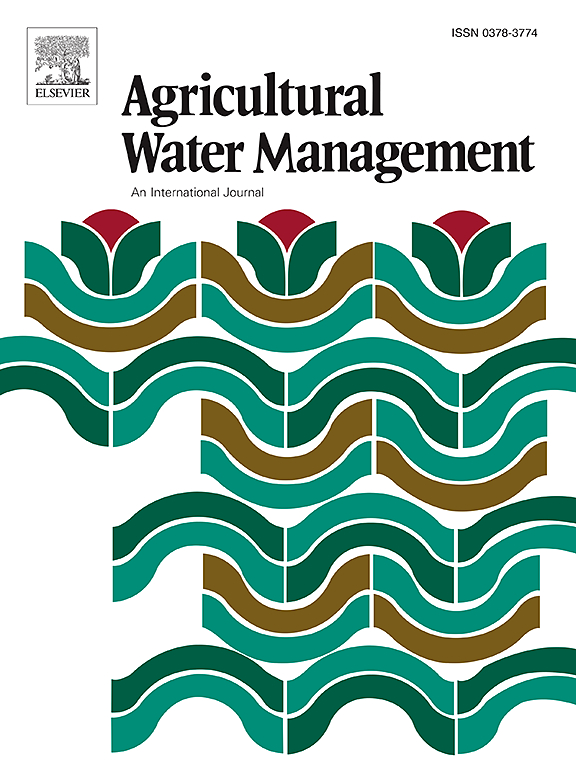生物炭减少了中国辽河下游平原干湿交替条件下水稻生态系统的氮损失
IF 6.5
1区 农林科学
Q1 AGRONOMY
引用次数: 0
摘要
在土壤中添加生物炭被广泛用于提高固碳和减少化肥氮损失。然而,关于生物炭对水分胁迫下水稻生态系统中反应性气态氮损失、氮淋失和谷物产量的影响的研究很少,尤其是在下辽河平原这个渗水量较大的地区。我们的试验于 2020 年和 2021 年进行,采用分小区设计,以连续大水漫灌和干湿交替灌溉为主小区,不添加生物炭和添加 20 t-ha-1 稻壳衍生生物炭为副小区。结果表明,交替湿润灌溉和干燥灌溉分别减少了 15.9% 和 11.3% 的氮浸出和活性氮损失,但也分别增加了 5.0% 和 210% 的季节性累积 NH3 挥发量和 N2O 排放量。在 2020 年,稻壳衍生生物炭的添加大大减少了季节性累积 NH3 挥发量和 N2O 排放量,分别减少了 8.8 % 和 19.7 %;在 2021 年,分别减少了 20.7 % 和 19.2 %;在 2021 年,无机氮沥滤和活性氮损失分别减少了 8.3 % 和 14.1 %。与不添加生物炭的情况相比,添加生物炭并交替润湿和干燥,可使 2020 年的累积 NH3 挥发量和 N2O 排放量分别减少 7.3% 和 19.3%,2021 年分别减少 22.7% 和 22.0%。在干湿交替灌溉条件下,生物炭在这两年的无机氮浸出量与未添加生物炭时没有差异,但在 2021 年显著减少了 17.8% 的活性氮损失,有效抑制了干湿交替灌溉对活性氮损失增加的负面影响。因此,在干湿交替条件下的水稻生态系统中添加生物炭可以实现水资源的可持续利用,提高土壤固氮能力,减少氮损失。本文章由计算机程序翻译,如有差异,请以英文原文为准。
Biochar decreased N loss from paddy ecosystem under alternate wetting and drying in the Lower Liaohe River Plain, China
Biochar addition to soil is widely utilized to enhance carbon sequestration and reduce fertilizer N losses. However, little research has been studied on the effect of biochar on reactive gaseous N losses, N leaching and grain yield in paddy ecosystems under water stress, especially in the Lower Liaohe River Plain with a higher water percolation. Our experiment was carried out in 2020 and 2021 utilizing a split-plot design with continuously flooding irrigation and alternate wetting and drying irrigation as main plots and without biochar addition and with 20 t·ha−1 rice husk-derived biochar addition as sub-plots. The results showed that alternate wetting and drying irrigation respectively, decreased N leaching and reactive N losses by 15.9 % and 11.3 % but also respectively, increased seasonal cumulative NH3 volatilization and N2O emissions by 5.0 % and 210 % on average. Rice husk-derived biochar addition significantly mitigated seasonal cumulative NH3 volatilization and N2O emissions by 8.8 % and 19.7 % in 2020, 20.7 % and 19.2 % in 2021, respectively, and decreased inorganic N leaching and reactive N losses by 8.3 % and 14.1 % in 2021. Biochar addition coupling with alternate wetting and drying respectively, mitigated cumulative NH3 volatilization and N2O emissions by 7.3 % and 19.3 % in 2020, and, 22.7 % and 22.0 % in 2021 as compared to that without biochar. Biochar did not differ from without biochar in inorganic N leaching under alternate wetting and drying irrigation in both years but significantly reduced reactive N losses by 17.8 % in 2021, which efficiently inhibited the alternate wetting and drying induced negative effects on the increase in reactive N losses. Therefore, biochar addition to paddy ecosystems under alternate wetting and drying could realize sustainable utilization of water resources, increase soil N fixation, and mitigate N losses.
求助全文
通过发布文献求助,成功后即可免费获取论文全文。
去求助
来源期刊

Agricultural Water Management
农林科学-农艺学
CiteScore
12.10
自引率
14.90%
发文量
648
审稿时长
4.9 months
期刊介绍:
Agricultural Water Management publishes papers of international significance relating to the science, economics, and policy of agricultural water management. In all cases, manuscripts must address implications and provide insight regarding agricultural water management.
 求助内容:
求助内容: 应助结果提醒方式:
应助结果提醒方式:


